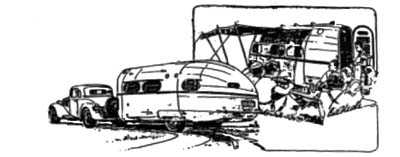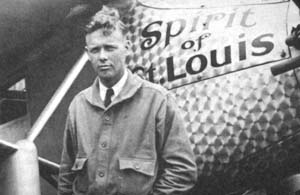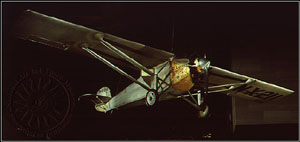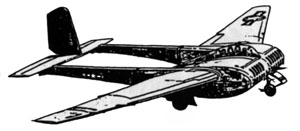Hawley Bowlus
&
Bowlus-Teller Trailers
Welcome, and thank you for your interest in Hawley Bowlus and Bowlus-Teller Trailers.

Bowlus Road Chief trailer
Information herein is provided by a small group of people interested in Bowlus trailers and their designer, Hawley Bowlus:
Who was Hawley Bowlus?
Bowlus was building full size gliders by 1910. Working as an aircraft mechanic in the US Army Air Service during Work War I, he honed his skills as an aircraft designer and mechanic. After the war, he continued to build aircraft.
In 1927 Hawley Bowlus was the shop foreman for Ryan Airlines when the "Spirit of St. Louis" was built by that (misnamed) company for Charles Lindbergh --
Gar Williams (in 1999) is restoring a 1935 Bowlus - Teller "Road Chief" trailer. He has restored and flown a number of airplanes.
In the past, our web space was provided by Gar.
Grant MacLaren created this web site. [
more about Grant ]
Grant is interested in lightweight travel trailers, Model "A" Fords,
Pietenpol airplanes
and various other artifacts of the 1920's and 30's. (In the 1960's MacLaren worked for R. Buckminster Fuller, inventor of the Dymaxion Car. MacLaren now wonders if Fuller knew Bowlus.)
Raul Blacksten, Vintage Sailplane Association Archivist
raulb@earthlink.net
VSA Homepage -- http://www.iac.net/~feguy/VSA
(If you visit the VSA website, be sure and visit the Archives maintained by Raul at home:earthlink.net/~raulb . . . gem)
William Hawley Bowlus was born May 8, 1896 in Illinois. He died August 27, 1967.

Charles Lindbergh

Spirit of St. Louis
It was Hawley Bowlus, not Claude Ryan, who made the airplane to Lindbergh's specification. Ryan no longer owned the company when "NYP" was built. There are other close links between Hawley Bowlus and Charles Lindbergh.
As told by Hawley's wife Ruth, after Lindbergh's Atlantic crossing Lindbergh asked Hawley what he could do for him (they had become good friends -- Lindbergh had stayed in Bowlus' home.) Hawley said Lindbergh could give him NYP's spinner. The spinner is signed on the inside to Lindbergh by the members of the Ryan crew and not to Bowlus.
Ruth Bowlus had the spinner in her possession until recently (this written in 1999.) Now, the spinner that made the famous flight is in Washington DC at the National Air and Space Museum.
In 1930, Bowlus designed and built the first U. S. high-performance sailplane. Following accepted practices of the German originators of the art of soaring, his "Albatross" sailplane featured wing tip ailerons, balanced rudder and elevator:

The Wright Brothers had established a soaring record in 1911 with a time aloft of 14 minute, 28 seconds. Although that record had been broken by Ralph S. Barnaby in a German-built
Charles and Anne Lindbergh learned to fly gliders in San a Diego-built Bowlus
By 1932, his sailplanes had evolved into the Bowlus/duPont series later know as the Senior Albatross (designed by Bowlus and, some say, Martin Schempp.)
Many, possibly 90 or so, Bowlus 'Baby Albatross' kits were sold and built (below) during the years 1936 - 1941:

In 1943, during flight tests, the Bowlus-designed XCG-16 cargo glider crashed, killing Hawley's good friends Howie Morrison and Richard duPont. Bowlus never really recovered from the loss:

Why the name Bowlus-Teller?
Hawley Bowlus was president and general manager of the Bowlus-Teller Manufacturing Company.
Jacob Teller was treasurer of the company.
The company was located at 13785 Paxton Avenue, San Fernando 169, California, USA. The company was bankrupt in 1936.
Tell me more about the trailer restoration by Gar Williams
Here's an edited excerpt from an email written by Gar Williams to a friend in Russia:
"This is a picture of an old travel trailer I am restoring for myself and thought it would give you a chance to see who is sitting at this end of the cyberlink. I am the gray haired guy on the left. The fellow on the right is a good friend, Terry Oberer from St. Louis and is probably one of the most knowledgeable Model "A" Ford mechanics in the world.
"The trailer is a 1935 Bowlus "Road Chief" manufactured by the Bowlus-Teller Manufacturing Company, located in San Fernando, CA in the mid-thirties.
"There are about twenty Bowlus trailers remaining out of about 140 originally built.
"My wife and I will use it for summertime camping trips."
In early 1999, a particularly knowledgeable visitor to this web site provided us with the following information. We are very grateful!
Bowlus' glider companies were:
- Bowlus Sailplane Co., Ltd. (1928-31 & 1936-43),
- Bowlus-duPont Sailplane Co., Ltd. (1933-36),
- General Airborne Transportation (1941-44), or
- Bowlus-Nelson Sailplane Co. (1945)
The trailers were built either by Bowlus Manufacturing or Bowlus-Teller Manufacturing. (See The 35-36 Bowlus - Teller Catalog/Price List on this site . . . gem)
When building the Spirit of St. Louis, Bowlus worked for the (misnamed) Ryan Airlines, not for Ryan Aircraft.
Bowlus never worked for Ryan Aircraft, which was a later (1930) company formed by T. Claude Ryan, and is now known as Teledyne-Ryan Aerospace.
Claude Ryan had sold out prior to the building of The Spirit of St. Louis. It was B. F. Mahoney who owned Ryan Airlines in 1927. It later became Mahoney-Ryan Aircraft before he sold it to Lindbergh's backers. It moved to St. Louis in 1928 or '29, and later went bankrupt.
A biography of Ryan says that he was in Los Angeles when Lindbergh's telegram came. I have heard from other sources that he was not even in the country. Ryan did, it seems, consult on the Spirit, but was not officially part of the company.
However, Bowlus and Ryan, together, did design the aircraft upon which the Spirit of St. Louis was ultimately based, the Ryan M-1 (The Spirit was actually a modified M-2 Brougham.)
I need to update my webpage. I have learned so much since I first posted it due to my researching a book on Bowlus.
Please keep me advised of your progress on the webpage.
Wishing You Green Air!,
Raul Blacksten. . . . . . CG-4A
Vintage Sailplane Association Archivist
raulb@earthlink.net
VSA Homepage --
http://www.iac.net/~feguy/VSA
My (VSA Archives) Homepage --
http://home.earthlink.net/~raulb
(If you visit the VSA website, be sure and visit the Archives maintained by Raul at home:earthlink.net/~raulb . . . gem)